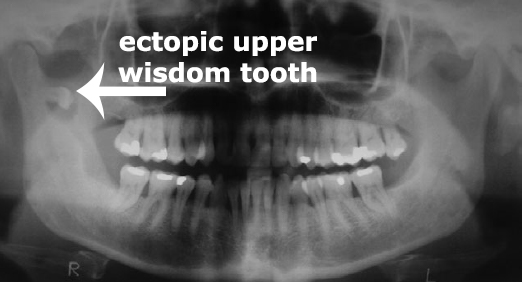One of the medically necessary valid reasons that the American Association of Oral and Maxillofacial Surgeons gives for removal of a wisdom tooth is if it is in an ectopic position. So the question is what exactly is the ectopic wisdom tooth and what should one do about it?
In the article titled “Removal of ectopic mandibular third molar teeth: literature review and a report of three cases” written by Ahmed and Speculand appearing in Oral Surgery in 2012 (vol. 5, pp. 39-44) discussion is made of a literature review of ectopic wisdom tooth along with three cases of lower ectopic wisdom teeth. In the article titled “Ectopic wisdom tooth in the condyle area” written by Mourouzis et al. appearing in Oral Surgery in 2011 (vol. 4, pp. 194–196) discussion is made of an upper ectopic wisdom tooth in a rare position. In the article titled “An unusually placed ectopic mandibular third molar: case report and discussion of management” written by Payne et al. appearing in Oral Surgery in 2012 (vol. 5, pp. 155–157) a discussion is made of an ectopic lower wisdom tooth. According to the article by Ahmed and Speculand an ectopic wisdom tooth is usually an incidental finding from a radiograph and such teeth can be left in place unless they are causing symptoms or have associated pathology. When a wisdom tooth is grossly displaced it may be referred to as ectopic such as positioned up into the ramus or down below the level of the mandibular nerve. However, when ectopic wisdom teeth are present it is usually a result of a cyst that is also present but could also be potentially due to lack of space, trauma, or aberrant tooth eruption. If removal of an ectopic wisdom tooth is needed surgery is describing as being demanding and various operation approaches can be used depending on the position of the tooth.
In the article by Ahmed and Speculand they found 23 cases of an ectopic wisdom tooth in 21 journal articles covering the time from 1976 to 2010. The authors state:
“With regard to site, eight of the ectopic mandibular third molars [wisdom teeth] were located in the condyle, five were described as subcondylar, three in the angle, three in the ramus (one of which was bilateral) two in the coronoid process, one at the sigmoid notch, and one bilateral case was described as being in the condyle and ramus.”
In 18 of the 23 cases reviewed in the literature review surgical removal of the ectopic lower wisdom tooth was performed. Ahmed and Speculand also add three cases of surgical removal of ectopic lower wisdom teeth with one in a 38 year old female, another in a 52 year old female, and another in a 36 year old female. In all three of these cases presented the patients repeatedly were given antibiotics to treat infections and were associated with cysts. Mourouzis adds a case of surgical removal of an ectopic upper wisdom tooth using an intra-oral approach for a 41 year old woman that also had an infection and was associated with a cyst. Payne adds a case of surgical removal of an ectopic lower wisdom tooth using an extra-oral approach for a 64 year old woman associated with a cyst.

There are 4 possible surgical approaches for removal of ectopic wisdom teeth: 1) sagittal split osteotomy, 2) intra-oral approach, 3) extra-oral approach and 4) endoscopic approach. They state that some ectopic wisdom teeth can be removed with a intra-oral approach but an extra-oral approach may be required in some cases. In the intra-oral approach there is a high risk of high risk of damage inferior alveolar nerve along with significant alveolar bone loss. In the extra-oral approach skin by the lower face near the neck is exposed and will leave a facial scar. In addition with the extra-oral approach there is risk of damage to the facial nerve. Thus it appears that extraction of ectopic wisdom teeth is associated with a higher risk of complications occurring than regular wisdom teeth and more likely need to be surgically removed because they are often associated with infection and cysts.
